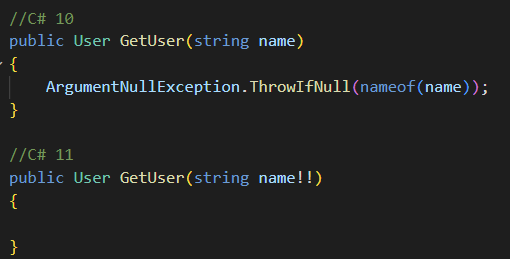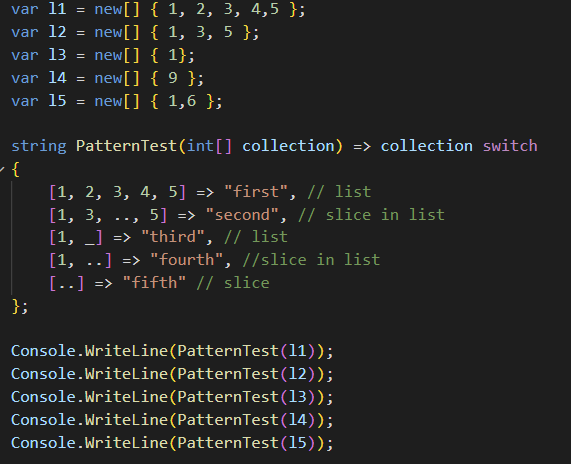C#11新特性整理
假期中有時間,整理了C#11的各個新特性,簡單分享給大家。
一、使用VSCode新建一個.NET7.0的Console工程

<Project Sdk="Microsoft.NET.Sdk"> <PropertyGroup> <OutputType>Exe</OutputType> <TargetFramework>net7.0</TargetFramework> <RootNamespace>_NET7</RootNamespace> <ImplicitUsings>enable</ImplicitUsings> <Nullable>enable</Nullable> </PropertyGroup> </Project>
二、泛型屬性
C # 11為開發人員提供了一種編寫自定義通用屬性的方法。
public class CommonAttribute<T> : Attribute { public T Property {get;set;} public CommonAttribute() { } public CommonAttribute(T realvalue) :this() { Property = realvalue; } }
新建一個類,在屬性上使用這個通用屬性註解。原先是多個屬性註解型別,現在一個泛型屬性就可以搞定了
public class User { [CommonAttribute<int>] public int UserID { get; set;} [CommonAttribute<string>("defaultValue")] public string UserName { get; set;} }
三、非空校驗
原先在C#10中,可以這麼寫實現引數非空校驗
public User GetUser(string name) { ArgumentNullException.ThrowIfNull(nameof(name)); // Rest of code }
在C#11中,在引數上加2個!就實現了非空校驗

四、字串內的換行符
字串內插的 { 和 } 字元內的文字現在可以跨多個行。
{ 和 } 標記之間的文字分析為 C#。 允許任何合法 C#(包括換行符)。
使用此功能可以更輕鬆地讀取使用較長 C# 表示式的字串內插,例如模式匹配 switch 表示式或 LINQ 查詢。
五、列表模式匹配
列表模式擴充套件了模式匹配,以匹配列表或陣列中的元素序列。
例如,當 sequence 為陣列或三個整數(1、2 和 3)的列表時,sequence is [1, 2, 3] 為 true。
可以使用任何模式(包括常數、型別、屬性和關係模式)來匹配元素。
棄元模式 (_) 匹配任何單個元素,新的範圍模式 (..) 匹配零個或多個元素的任何序列。
寫幾個列子看看:
var l1 = new[] { 1, 2, 3, 4, 5 }; if(l1 is [1, 2, 3, 4, 5] && l1 is [_,_,_,_,5]) { Console.WriteLine("List Pattern Matched"); }

上述程式碼中,[_,_,_,_,5] ,可以這麼理解:匹配長度為5且最後一個元素為5的任何集合。

同時,切片模式進一步放大了列表模式的威力。例如,如果需要將任何少於或等於5個元素的集合與最後一個元素5匹配,則可以將上述模式修改為
if (l1 is [.., 5]) { Console.WriteLine("List Pattern Matched 3"); }
這段程式碼中 [..,5] 等同於 l1.Length>=1 && l1[^1]==5.
偵錯輸出:List Pattern Matched 3
再寫一個Switch模式匹配的例子
var l1 = new[] { 1, 2, 3, 4,5 }; var l2 = new[] { 1, 3, 5 }; var l3 = new[] { 1}; var l4 = new[] { 9 }; var l5 = new[] { 1,6 }; string PatternTest(int[] collection) => collection switch { [1, 2, 3, 4, 5] => "first", // list [1, 3, .., 5] => "second", // slice in list [1, _] => "third", // list [1, ..] => "fourth", //slice in list [..] => "fifth" // slice }; Console.WriteLine(PatternTest(l1)); Console.WriteLine(PatternTest(l2)); Console.WriteLine(PatternTest(l3)); Console.WriteLine(PatternTest(l4)); Console.WriteLine(PatternTest(l5));

實際輸出:
first
second
fourth
fifth
third
六、原始字串
原始字串是字串的一種新格式。
原始字串可以包含任意文字,包括空格、新行、嵌入引號和其他特殊字元,無需跳脫字元(這個很關鍵、也很簡單)。
原始字串以至少三個雙引號 (""") 字元開頭。 它以相同數量的雙引號字元結尾。
通常,原始字串在單個行上使用三個雙引號來開始字串,在另一行上用三個雙引號來結束字串。 左引號之後、右引號之前的換行符不包括在最終內容中。
詳細的範例,可以看前段時間整理的一篇文章。
C#11新特性-Raw string literals原始字串研究、範例
以上是這幾天研究的C#11的新特性。分享給大家。
周國慶
2023/1/19